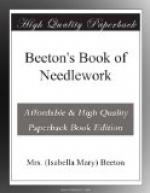* * * * *
KNITTING.
287.—KNITTING, though considered to be an old-fashioned art, is by no means so ancient as lacemaking. Knitting has never entirely quitted the hands of English and German ladies; indeed, among all good housewives of any civilised country, it is reckoned an indispensable accomplishment. Knitting schools have been established of late years both in Ireland and Scotland, and Her Majesty the Queen has herself set an example of this industry, as well as largely patronised the industrial knitters of Scotland. Of the rudiments of this useful art many ladies are at present ignorant; it is in the hope of being useful to these that the following instructions are offered.
To knit, two, three, four, or five needles, and either thread, cotton, silk, or wool are required.
Knitting needles are made of steel, of ivory, or of wood; the size to be used depends entirely upon the material employed, whether thread, cotton, silk, single or double wool, for knitting. As the size of the needles depends upon that of the cotton, a knitting gauge is used (see No. 287). The gauge (page 290) is the exact size of Messrs. H. Walker and Co.’s knitting gauge. Our readers will remark that English and foreign gauges differ very essentially; the finest size of German needles, for example, is No. 1, which is the size of the coarsest English wooden or ivory needle. Straight knitting is usually done with two needles only for round knitting for socks, stockings, &c., three, four, and five needles are employed.
[Illustration: 287.—Knitting Gauge.]
* * * * *
288.—Casting On.
This term is used for placing the first row or round of knitting stitches on the needles—“casting them on”—and is done in two ways—by “knitting on” the stitches, or as follows:—
Hold the thread between the first and second finger of the left hand, throw it over the thumb and first finger so as to form a loop, and pass the needle in the loop; throw the thread lightly round the needle, pass it through the loop, and draw up the thread; this forms the first stitch (see No. 288).




